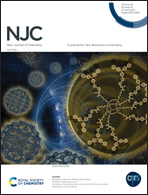Synthesizing a surface-imprinted polymer based on the nanoreactor SBA-15 for optimizing the adsorption of salicylic acid from aqueous solution by response surface methodology†
Abstract
A novel salicylic acid (SA) molecularly imprinted polymer (MIP) has been synthesized successfully by a surface imprinting technique based on the SBA-15 nanoreactor. SBA-15, selected as the nanoreactor for immobilizing the monomers and template molecules, would be an option to develop a new SA imprinting strategy. The obtained imprinted materials were characterized by Fourier transmission infrared spectrometry (FT-IR), scanning electron microscopy (SEM), transmission electron microscopy (TEM), X-ray diffraction (XRD) and nitrogen adsorption–desorption isotherms. The results suggested that MIP possessed an excellent ordered hexagonal mesoporous structure, which preserved the highly ordered mesoporous structure of SBA-15. Experimental variables influencing the adsorption process, including the initial pH, initial concentration and temperature, were optimized by the three-level Box–Behnken experimental design with the three factors combining the response surface method (RSM) for the first time. The optimal adsorption conditions were obtained to achieve the maximum adsorption capacity of SA as follows: initial solution pH 4.62, initial SA concentration 52.38 mg L−1, and temperature 35.0 °C. Under these conditions, the experimental value of the adsorption capacity was 44.435 mg g−1, which was very close to the predicted value (43.429 mg g−1). Furthermore, the adsorption isotherm and selectivity towards SA onto MIP and non-imprinted polymer (NIP) were investigated, indicating that MIP had splendid recognizing ability and a superior specific adsorption capacity (145.19 mg g−1) compared to that of NIP (64.30 mg g−1) at 35 °C. Meanwhile, MIP was regenerated and found to be suitable for reuse in successive adsorption–desorption cycles five times without significant loss in the adsorption capacity. The results suggested that MIP could be used as an excellent adsorbent for the efficient removal of SA from aqueous solution.



 Please wait while we load your content...
Please wait while we load your content...